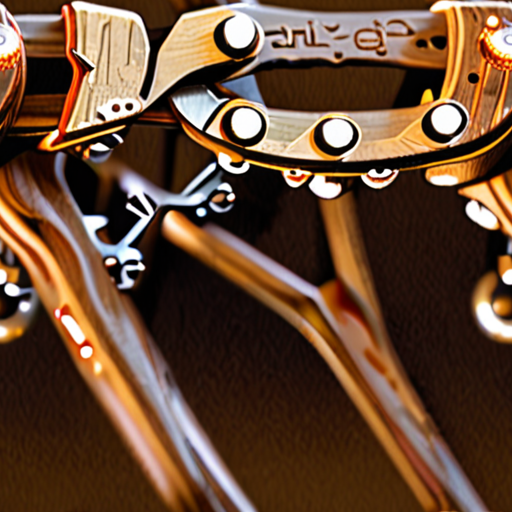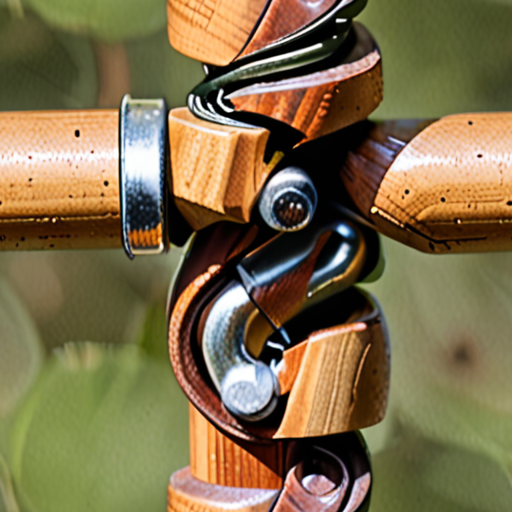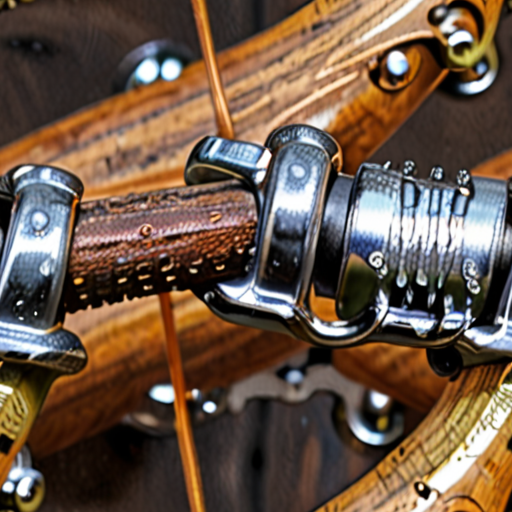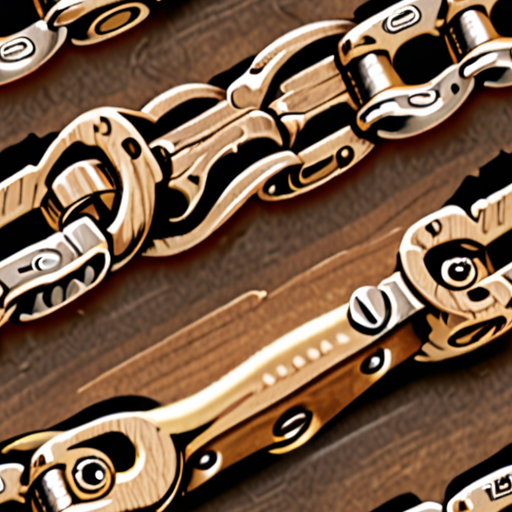Keeping your bike chain well-maintained is crucial for ensuring smooth rides, preventing costly repairs, and extending the lifespan of your vehicle. Regular bike chain maintenance involves a combination of cleaning, lubrication, and inspection to remove dirt, grime, and wear from the chain’s moving parts. Neglecting these tasks can lead to decreased efficiency, increased friction, and even catastrophic failures. In this comprehensive guide, we’ll delve into the essential practices for maintaining a healthy bike chain, covering topics such as choosing the right tools, best practices for cleaning, lubricating, and greasing, as well as signs that indicate your chain needs attention.

Maintaining a Bike Chain
As a cyclist, regular bike chain maintenance is crucial to extend the lifespan of your drivetrain and prevent costly repairs.
- Cleaning the Chain
- Lubricating the Chain
- Inspecting and Replacing the Chain
To keep your bike chain running smoothly, start by cleaning it regularly. Use a soft-bristled brush to remove any loose debris and then apply a chain cleaner or degreaser to dissolve grime and grease.
After cleaning, apply a lubricant specifically designed for bike chains. There are two types of lubricants: wet and dry. Wet lubricants provide better protection against corrosion and wear, while dry lubricants offer improved durability and reduced mess.
Regularly inspect your chain for signs of wear, such as rust, corrosion, or excessive stretching. If you notice any damage, consider replacing the chain to prevent further issues.
At Leeds Bicycle, we recommend checking your chain every 100 miles or after a particularly tough ride. By following these simple steps, you can keep your bike chain in top condition and enjoy a smoother, more efficient ride.
We also suggest consulting our bike maintenance tips for more information on how to properly care for your bike.
Additionally, consider investing in a chain tool, which allows you to adjust and replace your chain quickly and easily.
For more information on bike chain maintenance, visit our friends at Shimano or Campagnolo .
Is WD40 Suitable for Bike Chains?
As a cyclist, it’s essential to keep your bike chain well-maintained to ensure smooth pedaling and prevent damage to your drivetrain.
- WD40 is a popular choice among cyclists due to its ability to remove grease and grime from bike chains.
- However, it’s crucial to understand the limitations of WD40 when it comes to bike chain maintenance.
The Pros of Using WD40 on Bike Chains:
WD40 can be effective in cleaning and degreasing bike chains, especially when dealing with stubborn grime and rust.
- It helps to loosen stuck links and free up the chain’s movement.
- WD40 can also protect metal surfaces from corrosion and rust.
The Cons of Using WD40 on Bike Chains:
While WD40 may seem like a convenient solution for bike chain maintenance, it has several drawbacks.
- WD40 can leave behind a residue that attracts dirt and dust, leading to premature wear on the chain and other components.
- It can also compromise the lubrication properties of the chain, causing it to wear down faster.
A Better Alternative:
Instead of relying on WD40, consider using a dedicated bike chain lube specifically designed for your type of riding and climate.
- Bike-specific lubes are formulated to provide long-lasting protection against corrosion and wear.
- They’re also designed to work seamlessly with your chain’s materials, ensuring optimal performance and longevity.
Best Practices for Bike Chain Maintenance:
To keep your bike chain running smoothly and prolong its lifespan, follow these best practices:
- Clean your chain regularly using a soft brush and mild soap solution.
- Apply a thin layer of bike-specific lube to the chain, making sure to wipe off any excess.
- Regularly inspect your chain for signs of wear and replace it as needed.
Conclusion:
While WD40 may have its uses in bike chain maintenance, it’s not the most effective or recommended solution. By understanding the pros and cons of WD40 and adopting better alternatives, you’ll be able to keep your bike chain running smoothly and prolong its lifespan.

How Often Should You Lubricate Your Bike Chain?
Lubricating your bike chain is crucial to extend its lifespan and prevent damage to your drivetrain.
- As a general rule, it’s recommended to clean and lubricate your bike chain at least once a month, or every 100-150 miles, whichever comes first.
- The frequency may vary depending on the conditions in which you ride, such as riding in dusty or wet environments.
At Leeds Bicycle, we recommend checking your chain regularly and cleaning and lubricating it as needed.
- Look for signs of wear and tear, such as rust, corrosion, or excessive friction.
- Clean the chain thoroughly with a soft brush and mild soap solution.
- Apply a few drops of lubricant to the chain and wipe off any excess with a cloth.
Some popular bike chain lubricants include:
- Peloton Chain Lube
- Muc-Off Dry Lube
- Finish Line Wet Lube
Remember to always follow the manufacturer’s instructions for application and usage.
For more information on bike maintenance and repair, check out our bike maintenance tips page.
We also recommend visiting our bike repair services page for professional assistance with chain maintenance and other repairs.
At Leeds Bicycle, we’re committed to helping you get the most out of your bike and enjoy a safe and enjoyable ride.

Do Bike Chains Need to Be Greased?
Bike chains require regular maintenance to function smoothly and prolong their lifespan.
- Greasing a bike chain helps reduce friction between the chain’s pins and rollers, allowing it to move freely and efficiently.
- A well-lubricated chain reduces wear and tear on the drivetrain components, minimizing the risk of damage and costly repairs.
- Regular cleaning and lubrication also prevent corrosion and rust buildup on the chain, which can lead to premature failure.
The Importance of Proper Lubrication
Lubricating a bike chain involves applying a suitable grease or lubricant to the chain’s moving parts, typically every 100-200 miles or after exposure to harsh weather conditions.
- Choose a high-quality lubricant specifically designed for bike chains, taking into account factors like temperature, humidity, and riding style.
- Apply the lubricant evenly along the chain’s length, making sure to cover all moving parts, including the pins, rollers, and bushings.
- Wipe off excess lubricant with a clean cloth or paper towel to prevent dirt and grime accumulation.
Tips for Effective Chain Maintenance
To keep your bike chain running smoothly and prolong its lifespan:
- Clean the chain regularly using a soft brush and mild soap solution.
- Inspect the chain for signs of wear, such as fraying, rust, or excessive wear on the pins and rollers.
- Replace the chain according to the manufacturer’s recommendations or when showing significant wear.
By following these guidelines and incorporating regular chain maintenance into your routine, you’ll enjoy a smoother ride, reduced wear on your drivetrain components, and extended chain lifespan.
How to Tell if Your Bike Chain Needs Lubrication
To keep your bike running smoothly, regular chain lubrication is essential.
- Check your chain regularly for signs of wear and tear, such as rust, corrosion, or excessive wear on the pins and rollers.
- Listen for unusual noises while pedaling, such as squeaking or grinding sounds, which can indicate dry or worn-out chain components.
- Inspect individual chain links for dirt buildup, tight links, or bent pins, which can cause friction and lead to premature wear.
- Rotate the pedals slowly to check for smooth movement and any resistance or stiffness in the chain.
- Consult your bike’s manual or manufacturer’s guidelines for recommended lubrication intervals and types of lubricants suitable for your chain.
When choosing a lubricant, consider factors such as temperature range, durability, and compatibility with your chain type.
- For general-purpose use, look for water-resistant or waterproof lubricants that can withstand various weather conditions.
- For high-performance applications or extreme temperatures, opt for specialized lubricants designed for those specific conditions.
- Avoid using petroleum-based products, as they can attract dirt and dust, leading to premature wear and reduced performance.
- Consider eco-friendly options or biodegradable lubricants for environmentally conscious riders.
Remember to always clean your chain before applying lubricant to remove dirt and debris, ensuring optimal performance and extending the life of your chain.
At Leeds Bicycle, we recommend checking your chain every 100-200 miles or after exposure to harsh weather conditions to maintain peak performance and prevent costly repairs.
Visit our maintenance guides for more detailed information on bike care and troubleshooting common issues.
For professional assistance or personalized advice, consult our team of experts at Leeds Bicycle.

Should I Dry or Wet My Bike Chain?
When it comes to maintaining your bike chain, choosing between dry and wet lubricants can be a bit confusing.
- Dry chain lube is ideal for dry conditions, as it provides a thin layer of protection against friction and wear.
- On the other hand, wet chain lube excels in wet conditions, offering superior corrosion resistance and lubrication.
However, there are situations where you may need to choose between these two options:
- Riding in Dry Conditions: In dry weather, dry chain lube is the better choice. It helps reduce friction and wear on the chain, making pedaling smoother and more efficient.
- Riding in Wet Conditions: When riding in rainy or humid environments, wet chain lube is the way to go. Its thicker consistency provides extra protection against corrosion and keeps the chain running smoothly.
- Mix of Both: If you’re unsure whether to use dry or wet lube, consider the terrain and weather forecast. For example, if you’ll be riding on a mix of paved roads and trails, a hybrid lube might be the best option.
At Leeds Bicycle, we recommend checking your chain regularly and adjusting your lubricant accordingly. Remember, a well-maintained chain is essential for optimal performance and longevity.
Why Choose the Right Lubricant?
Avoiding the wrong lubricant can lead to premature wear, increased friction, and even damage to your drivetrain components.
- Reduced Wear: Using the correct lubricant reduces wear on your chain and other drivetrain parts, extending their lifespan.
- Improved Performance: A well-lubricated chain ensures smooth pedaling and efficient power transfer, making your ride more enjoyable.
- Prevents Corrosion: Wet chain lube protects against corrosion, which can weaken your chain and other metal components.
Conclusion:
In conclusion, choosing the right lubricant for your bike chain depends on the conditions you’ll be riding in. By selecting the correct type of lube, you’ll enjoy improved performance, reduced wear, and extended component life. At Leeds Bicycle, we’re committed to helping you get the most out of your ride, and our expert staff are always happy to offer advice on bike maintenance and upgrades.

0 Comments